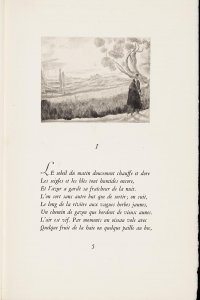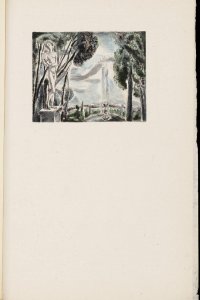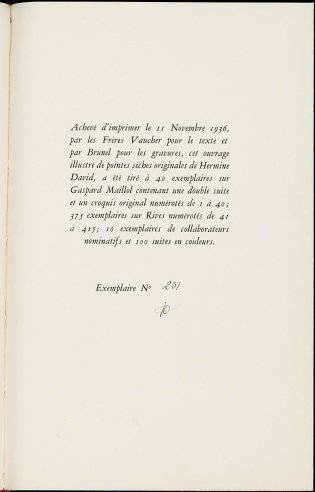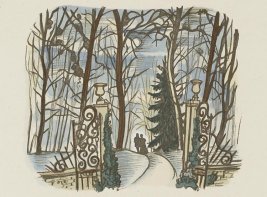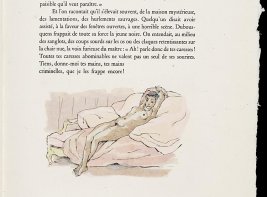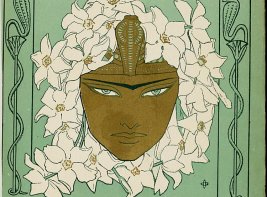La bonne chanson
Year: 1936
Author: Paul Verlaine (1844 - 1896)
Artist: Hermine David (1886 - 1970)
Publisher: Creuzevault
The Creuzevault edition appeared in 1936, with 21 etches by Hermine David. This artist was trained in Paris and made her début at the Women's Salon in 1904. In 1907 she met the painter Jules Pascin, whom she married in New York in 1915, and whom she considered her mentor. She painted sophisticated and imaginative aquarelles and gouaches, mainly of the landscape around Paris. She also produced lithographs and dry-point etchings. The scrupulous and tightly constructed etches have a spatial effect that attracted many collectors. David illustrated dozens of books, especially in the period 1920-1940, and continued to work until 1960. The illustrations conform subtly to the book's text, whether written by Byron, Maurois, Alain-Fournier or Verlaine. She also illustrated Verlaine's collection Romances sans paroles.
The smell of leather
Publisher Henri Creuzevault (1905-1971) was originally a painter, but applied himself to bookbinding from 1918 onwards, working in his father Louis Lazare Creuzevault's studio. After World War I, he began designing bookbindings: maquettes. The maquette was initially nothing but a drawing, but it could be developed into a full model. From 1928 onwards (when he won first prize at an exhibition in museum Galliéra), he collaborated with his brother: Henri did the design and decoration work, and Louis fashioned the binding. In France, strict division of work and specialisations like this were quite common. In 1936 the brothers opened their own bookstore and publishing business, but Louis died in 1937, at the young age of 25. Their publishing business produced about twenty books, for which Laboureur, Maillol, Laurens and others created the illustrations. Henri's bookbinding work received international acclaim. He later also designed carpets, and focused increasingly on the art trade. A six-volume homage to his work appeared in 1987.
The text of La bonne chanson was printed by Vaucher in 1936, and its etchings were done by Brunel. Two editions were published: 40 copies on Gaspard Maillol paper, with extra prints of the etchings and an original drawing of the artist, and 375 copies on BFK Rives. All copies bear the publisher's monogram. The copy owned by the Koninklijke Bibliotheek, National Library of the Netherlands is printed on Rives paper (number 251), but it does contain an extra series of the black-and-white etchings, and a hand-coloured set as well. Finally, an original signed gouache by Hermine David has been included in the front. It is a preliminary study of the illustration for the last poem: a sloping Paris street, with boscage and a view of another quarter. The copy is bound in a half-leather binding by D.H. Mercher. The name probably stands for Henri Mercher (1912-1976) - he once claimed to have become a bookbinder because he loved the smell of leather so much.
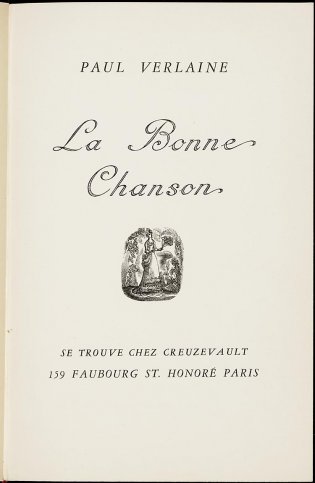
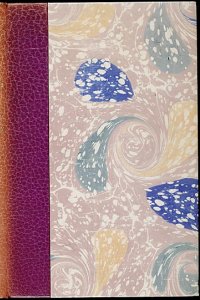

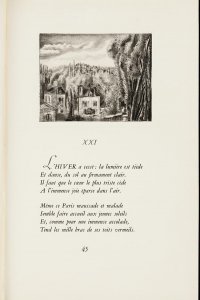
![Pagina [46]](/sites/default/files/styles/galerie/public/images/la-bonne-chanson-p46.jpg?h=600f45fb&itok=W8Zm09pI)
